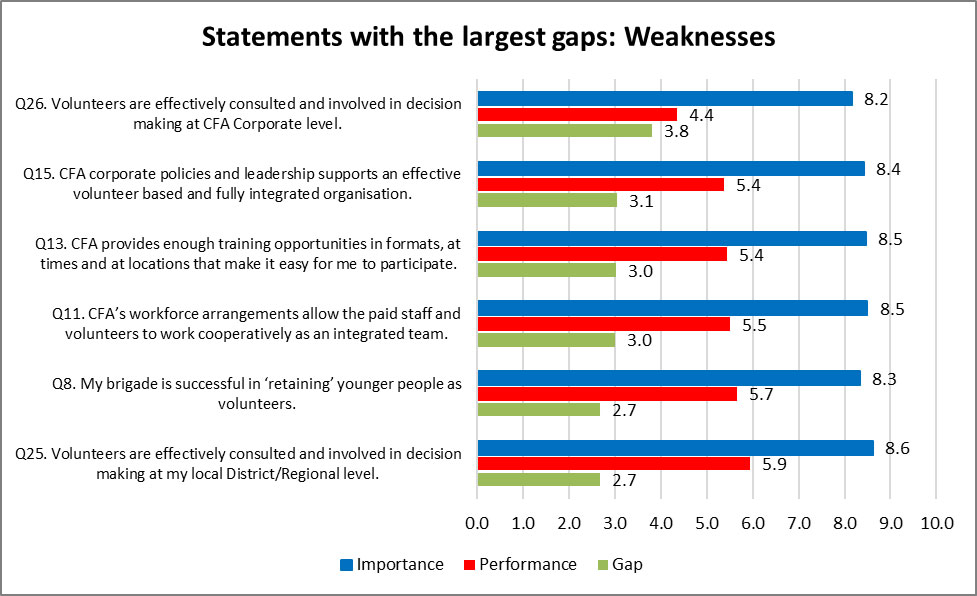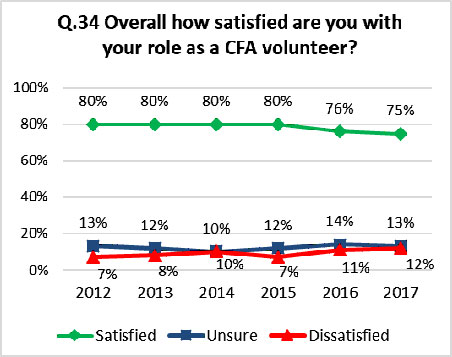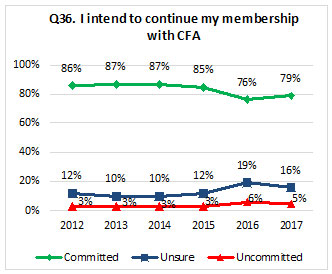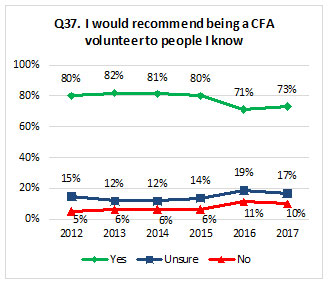NOTE TO MEMBERS – December 2017
Provided in this note to members are initial, high level results only. Further briefings on the results of the VFBV Volunteer Welfare and Efficiency Survey will be provided in the coming months and a detailed report will be published soon.
Background
The VFBV volunteer welfare and efficiency survey has now been conducted for the sixth consecutive year for CFA volunteers. The welfare and efficiency survey is an important tool, used by Volunteer Fire Brigades Victoria, to work with CFA, government and key stakeholders to provide evidence based feedback on matters affecting the welfare and efficiency of CFA volunteers. The survey continues to be valuable in providing feedback on what is going well and where things can be improved.
The survey was developed and introduced by VFBV in 2012. The survey was designed by and for volunteers, to better understand the issues as volunteers see them and to measure and understand how satisfied volunteers are with arrangements in place to support, encourage and enable them to do their work. Fundamental to the survey’s integrity and success is its facilitation and analysis undertaken by their volunteer association.
Who participated
There is very good engagement with the survey and beyond CFA, participation is strengthened by the additional involvement of fire service volunteers in most States, the Victorian State Emergency Service Volunteer Association and other emergency management volunteer involving organisations in Victoria.
CFA Respondents:
- The number of participants in 2017 remains high and provides statistically robust results representing volunteer views – 2653 CFA volunteers participated.
- 2017 had a higher percentage (18%) of female respondents compared to past surveys.
- There was good participation across all age groups, roughly reflecting CFAs age demographic.
- There was good representation from long serving volunteers right through to volunteers who have only been with the CFA for less than a year.
- Most participants (63%) said they are with rural brigades, the balance with urban (29%) or integrated brigades (7%). Less than 1% of those who responded indicated they were members of a CFA Coast Guard brigade.
- Most participants in the survey were either brigade members or leaders within their brigade, with 18% indicating they are in a broader leadership role beyond brigade level.
Preliminary Results: By Theme
33 Welfare and Efficiency Survey statements are grouped into 7 themes (see graph below). For each statement, participants provide a rating on the importance and performance on matters affecting volunteer welfare and efficiency. The size of the ‘gap’ between the two ratings is indicative of how closely volunteer expectations are being met (ie: the smaller the gap, the more closely volunteer expectations are to being met).
Results by theme are consistent with previous years, with no change to themes performing the best or worst.
- ‘People Management – My Brigade’ has the smallest gap of all themes.
- Cooperation across CFA’ has the largest gap of all themes.

Respondents identified the best performing areas as those which related to matters primarily involving their volunteer activities at a local brigade level.
Respondents judged areas relating to CFA organisational support/management, particularly around consultation and training, as the poorest performing.
Whilst ‘Training’ was again judged as the one of the worst performing areas, results indicate a slight improvement in scores when compared to previous years.
- Results for respondents who indicated they are members of rural brigades showed the highest satisfaction in all themes.
- Results when separated by gender showed little difference. Overall, females tended to rate both importance and performance higher. In most cases, the male respondents’ cohort had slightly worse results than those from the female cohort. The exceptions were ‘Recruitment and Retention’ and ‘People Management’, where the statements were scored slightly worse by females. (nb: the additional gender categories of: transgender; prefer not to say; and, other, only totaled 1.1% of respondents and therefore do not have their results reported separately)
- Respondents identifying as volunteer members of integrated brigades rated performance in all themes the lowest, with the exception of Training.
- Training was rated lowest by volunteers with urban brigades when compared with volunteers from rural and integrated brigades.
- Whilst the theme ‘People Management – My Brigade’ is rated the best of all the themes overall, results for respondents identifying as volunteer members of integrated brigades showed significantly worse results in this area.
- Volunteers who participated in the survey and identified as having leadership roles at a level broader than their brigade tended to be less satisfied with the performance across the themes when compared with those who identified as brigade members or leaders within their brigades.
- The survey responses show that respondents with less than one year of service are most satisfied, but then there is a marked decrease in satisfaction recorded by those with between 1 and 5 years of service. There is a further drop in satisfaction recorded for those in the 6 to 10 years’ service group.
Preliminary Results: Survey Statements
Of the 33 statements in the survey, the below table represents those where volunteers’ expectations are closest to being met.

This is a very similar list to last year.
Of the 33 statements in the survey, the below table represents those where volunteers’ expectations are furthest from being met.

Whilst Q11 has improved slightly on last year, the ratings given by volunteers who identified as being members of integrated brigades worsened significantly.
Statements relating to recruiting and retaining younger volunteers both recorded ratings which indicate performance is declining in this area.
Preliminary Results: Satisfaction
The overall number of volunteers satisfied with being a CFA volunteer continues to decline.
Volunteers with Integrated brigades are significantly less content with only 57% indicating they are satisfied. 78% of volunteers with rural brigades and 74% of volunteers with urban brigades indicated they are satisfied.
70% of volunteers who identified as brigade members are satisfied, compared to 79% who identified as being in leadership roles.

Satisfaction with the way volunteers are treated by CFA is showing no sign of improvement and is a figure that should be of significant concern to CFA.
Lower than the overall rating, only 42% of volunteers in broader leadership roles indicated they are satisfied.
59% of females compared to 46% of males are satisfied with the way they volunteers are treated by CFA.
Only 38% of volunteers who identified as members of integrated brigades indicated they are satisfied, with 43% indicating they are dissatisfied. Volunteers with rural brigades showed the highest levels for this question with 53% indicating they are satisfied. The number of volunteers with urban brigades who indicated they are satisfied was 42%.

Overall, there has been a slight improvement in those intending to continue their membership with CFA, however the results reviewed by brigade type is important to be understood.
Only 60% of volunteers with integrated brigades indicated they intend to continue volunteers, down from 66% in 2016. This is in contrast with volunteers in rural brigades where 82% have indicated they intend to continue (up from 77% in 2016). The ratings for volunteers with urban brigades remains consistent with 2016 at 77%.

Overall another slightly improved result with an increase in the percentage of volunteers who would recommend being a CFA volunteer to others.
Again, the results of volunteers with integrated brigades being least satisfied is evident here. Only 50% of these volunteers indicated they would recommend being a CFA volunteer to others, this was 61% in 2016. Results for volunteers with rural brigades has increased to 77% now recommending being a CFA volunteer, compared with 73% in 2016. The results for volunteers with urban brigades remains steady at 70%.

 Library
Library 
